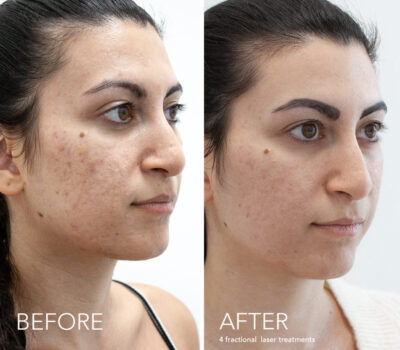Acne scars can be a reminder of the days when acne breakouts were part of your daily lives. All types of acne scars can be treated in clinic and for better results should be combined with a suggested at home skin care regiment.
At Dermamode we have a few different technologies that can treat acne scars by promoting a faster skin cell turnover and healthy skin in order to reduce the appearance of acne scars and/or hyperpigmentation. Depending on the type of scar and the severity, our specialists will help you find the treatment plan best suited for your skin.
Micro-needling is the process of inserting tiny needles into the skin surrounding to stimulate the body to make more collagen. This collagen may reduce the appearance of acne scars by smoothing out the skin.
Fractional laser treatment with PicoWay technology, penetrates under the skin for its impact, leaving the outer layer of the skin intact. Ultra-short pulses vaporize their targets before the skin overheats. This process helps rebuild the structure of the skin by stimulating the production of collagen and elastin which helps reduce the appearance of scars. This treatment is beneficial for more severe scars as well as for post-inflammatory hyperpigmentation.
Salicylic or Lactic Peels, Salicylic acid is a naturally occurring compound that is often used to treat acne prone skin types. Salicylic acid helps clear dirt, skin cells, and other debris that leads to acne from the pores of the skin. It also helps reduce swelling and redness in the area, which will intern help minimize the appearance of scarring. Salicylic acid is beneficial for all scar types and Lactic Acide treatments are equally beneficial but our specialists will determine which peel would be best for your skin. Chemical peels may be a good option for skin types that have acne scarring and still have active acne.
Microdermabrasion is a mechanical exfoliation that increases collagen and elastin for a more even skin texture and can promote healthy skin by promoting and increase in collagen and elastin production.

These scars usually occur during the healing process of a breakout when the body either produces too much collagen or not enough collagen – a substance that gives the skin support. Acne scars appear in different forms, the type of scar depends on how much collagen your body makes. When there is a loss of tissue it causes a pitted or depressed area and when there is an overgrowth of tissue it leaves a raised scar. There may also be scars in the form of a change in pigmentation, this is known as a post inflammatory scar. This develops when a wound (pimple) causes the skin to become inflamed and as the skin heals, it produces too much melanin.
Starting at / per treatment